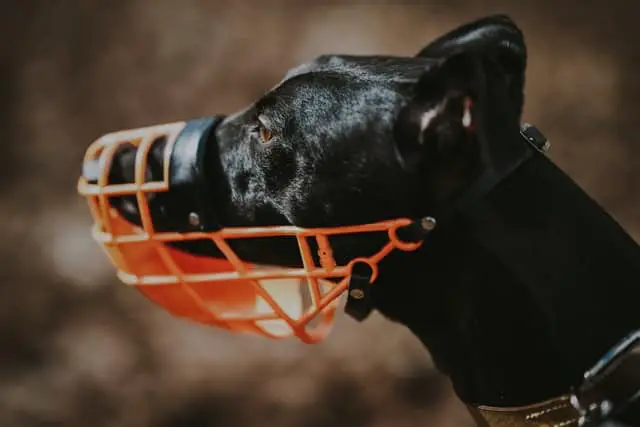Dogs that travel by public transport need to learn to use the muzzle, but first you have to know which one to buy and what tricks to use to get used to them.

Each locality and transport has its own regulations, but there is one that is common to almost all of them: traveling dogs must be provided with a leash and muzzle. This article explains which muzzle to buy for your dog and all the tricks to get him used to the muzzle .
Muzzles for dogs: necessary to travel in public transport
Almost 100% of urban dogs are used to walking on a leash without problem, since they have been used to them since they were puppies. If it hasn’t been done yet and the dog is pulling on the leash , you should start working on it as soon as possible.
The problem may be that the dog does not tolerate the muzzle because it has never had the need to use it, with the exception of dogs considered potentially dangerous , which have the obligation to always walk with a muzzle. But if you have to travel with the dog by metro, train or bus, and you do not want to have a disastrous experience, you will have to dedicate enough time and patience and prepare the pet in advance to tolerate the muzzle.
What dog muzzle to buy?
Two types of muzzles can be found on the market: cloth muzzles and basket muzzles. Cloth muzzles must be used at specific times , experts recall, since this type of muzzle prevents the dog from opening its mouth to eat, drink or pant. It should not be forgotten that panting can be dangerous for the animal, especially on hot days. While the human body uses sweating to expel heat, dogs only sweat through the pads and, to a greater extent, through panting.
Why are cloth muzzles for dogs not advisable? There is no problem if this muzzle is used only to travel with the dog by train, bus or metro a short distance, and as long as it is not hot in the cabin. But noises and other dogs can make your pet nervous. In this case, the cloth muzzle will be a problem: stress increases the dog’s panting, but these muzzles make it difficult, so the dog will become more nervous, making the trip by public transport a negative experience.Basket muzzles are much more recommended, since they allow the dog to open its mouth a little to pant and, even, some do not complicate that it can be given treats through its holes. If not, it always remains to be able to do them carefully with scissors.
In addition, there is a variant that, although aesthetically it may seem somewhat aggressive, is designed with the welfare and safety of the dog in mind: the baskerville- type muzzle. While most conventional dog muzzles can be easily pulled off by the dog with its paw, or with the help of the ground or the wall, the Baskerville muzzle has several safety straps that prevent the dog from getting out of it. In addition, these muzzles have a hole at the height of their mouth through which they can be awarded, something essential if you want to make a muzzle positive, that is, that the dog associates it with a pleasant experience.
How to accustom your dog to the muzzle? Tricks

The most important thing to turn the muzzle into something positive for the dog is to be patient and not expect results the first day. Rushing or forcing the pet to tolerate something too soon often has the opposite effect. The best thing is to take at least a week to, little by little, make sure that the muzzle is present in all the things that the dog likes the most : eating, playing, spending time with its owner , etc.
You just have to leave the muzzle nearby, without showing it too much or giving it importance. It is advisable to leave it by your side when you eat, hold it in your hand while playing with it or stroking it, and leave it within reach from time to time so that it can sniff and become familiar with it. Make sure it doesn’t bite or treat him like just another toy, but he shouldn’t be scolded or punished if he does. In this case, it is enough to remove it without giving it importance. And reward him every time he approaches the muzzle for his own leg!
Little by little, once it is clear that the muzzle does not pose a threat to them, you have to make it more present. You can try to hook it or tie it on the leash, so that it is at your height while you walk. This trick works as long as the walks are healthy and stress-free for him or his human.
After a couple of days following all the previous steps, you can try to put the muzzle on it for just a few seconds, without fastening it. This process should be repeated three or four times a day, always rewarding them once the muzzle is removed (do not exceed three or four seconds). If the answer is positive, you can also put some treats in the bottom of the basket and let the dog put his nose to catch them.
You can progressively increase the seconds that the dog spends with the muzzle on, as long as there is no negative response in it, and going back in the process, if it is seen that the seconds have been exceeded. If all goes well, you can try to fasten the muzzle and, as before, gently remove it in three or four seconds and reward again.
Another trick? When the dog is muzzled, it is very important to always do it sitting at its height, without invading its living space too much or doing it with its body or arms above its head, since this could create a feeling of helplessness and what is The goal is for you to be as relaxed as possible.
If, after several days of testing this at home, it is observed that the animal is calm and lasts even a few minutes, you can start going out to the street with the muzzle on, rewarding it for as long as it takes it. You do not have to exceed time so that the dog does not get nervous, because there is nothing worse than taking it off because it has become nervous. So it is advisable to anticipate events and if you think you are not liking the experience, take it off without giving it much importance and reward you again.
If the dog is able to tolerate the muzzle as one more routine on its walk, the muzzle will have been made positive and it will be ready to move on public transport with it, take it to the veterinarian, thus preventing it from biting or putting it on if it passes through any area where there are remains of things that you do not want him to pick up with its mouth.
